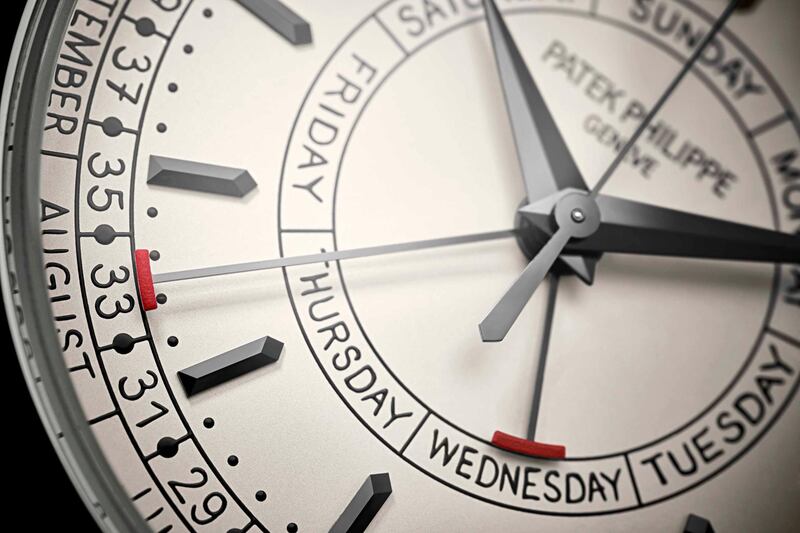The rickety tram ride from Basel’s old town to Messeplatz, or Exhibition Square, is a curious tableau. Medieval quaintness and winding streets quickly yield to the mighty Rhine, with the chimneys of big pharma spiking its banks in the distance. Over the river, the urbanity picks up again, but with city-limits mundanity and an edge of seediness. Then, suddenly, a sharp corner and you’re plunged into it: Baselworld, the world’s biggest watch and jewellery fair for more than 100 years.
Venturing inside Herzog & de Meuron’s metal-clad mothership of an exhibition hall, you’re swept along into a cavernous space roughly comparable to three Abu Dhabi mega-malls – all bolted together for seven days of wheeling and dealing to the tune of billions of dollars of trade.
Nonetheless, this year’s Baselworld should have been a far more subdued affair than ever, despite the bling-bling hyperbole. With the traditional trade-fair format (and even fashion-show formats) acquiescing to social-media-fuelled “see-now, buy-now” urgency, the show has haemorrhaged exhibitors in recent years, including its biggest, the Swatch Group. As expected, visitors were down by a hefty 22 per cent.
Put it down to the wall-to-wall sunshine or the surprisingly varied and gender-balanced novelties on show – whatever it was, this year’s fair still managed to defy all odds and prove to be a marquee year. Both product and industry optimism were in full bloom, and it was difficult to imagine any other event, webcast or hashtag replacing the buzzy relevance of Basel. Allow us to present the evidence.
Men's: Bvlgari Octo Finissimo Chronograph GMT Automatic
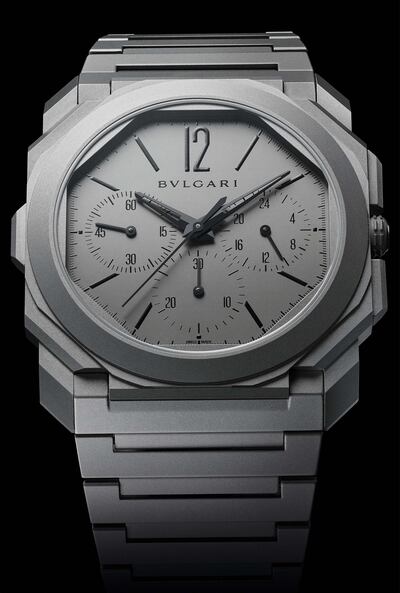
The Roman jeweller’s watch division has proved its Swiss-made credentials with formidable aplomb in recent years – not just through in-house factory autonomy, but also by establishing its Octo’s squashed ziggurat of monumental facets as the most important watch design of the 21st century (so far). On top of all that, Bulgari has the cheek to smash every ultraslim record going. Tourbillon, automatic watch, manually wound watch, chiming minute repeater, and now the least predictable yet: the thinnest-ever mechanical chronograph in watchmaking history, both manual and self-winding. It also manages to throw a second time-zone GMT function into the mix for good measure. Unpredictable because, despite its ubiquity, a stopwatch function is particularly hard to master – and Bulgari hadn’t even tried before, let alone down to wafer-like 3.3-millimetre slimness.
Hublot Classic Fusion Ferrari GT
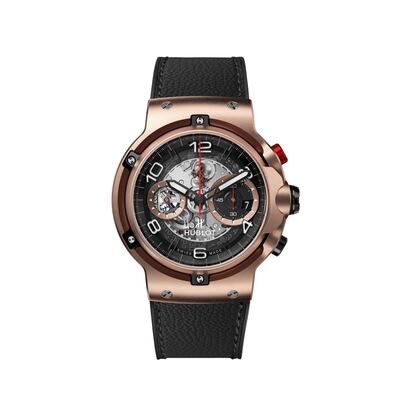
This extraordinary H R Giger-esque cyborg of a watch is the latest result of Hublot and Ferrari’s hand-in-hand design approach. Like 2017’s extraordinary Techframe, which celebrated Ferrari’s 70th anniversary – a watch whose attention to detail extended to screw recesses that echoed the rear diffuser of an F12tdf – this latest bit of epic horological experimentation has been conceived and designed by Ferrari itself, under the leadership of head of design Flavio Manzoni. It looks to the sinuous forms of Maranello’s finest Gran Turismo road cars for design inspiration, rather than the businesslike edge of the Scuderia’s F1 racers. For the new Ferrari GT, the starting point for Manzoni’s team at Centro Stile Ferrari was the Hublot Unico chronograph movement – the engine of the watch. Around this, they freely designed a high-performance, biomorphic chassis, a concentrical suspended element that enhances the sophisticated mechanics whirring away beneath.
Junghans Max Bill 100 Jahre Bauhaus
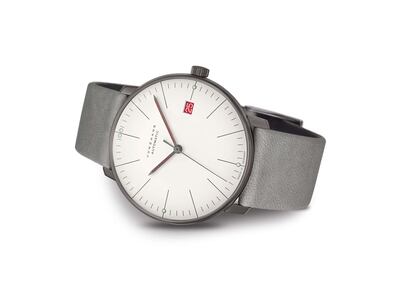
Junghans Max Bill 100 Jahre Bauhaus Like fellow countryman Nomos Glashütte, Junghans’ Max Bill collection is defined by the minimalist modernity of Germany’s Bauhaus movement – the difference here being direct pedigree. The titular Herr Bill, a protégée of the influential school of design’s founder Walter Gropius, created an alarm clock for Junghans in 1956, its crisp dial sashaying into wristwatch form in the 1960s. Like Nomos’s Tangente, its design language is so on point, it has remained untouched for more than half a century. To mark Bauhaus’s 100th anniversary this year, a cocktail of flourishes have been worked into Junghans’s purest Max Bill, all of which pass muster: a prime-red date display, contrasted by a strap and PVD case coating in grey that emulate the concrete cladding of the school building in Weimar. Flip side, Junghans has sought special dispensation to reveal the mechanics through the clear caseback – a flourish of technical pride that certainly wouldn’t pass muster at the Weimar school.
Patek Philippe Calatrava Ref. 5212A-001 Weekly Calendar
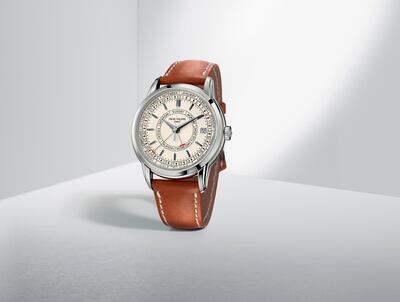
Winner of Baselworld 2019, hands down. Which is ironic, given the sheer number of actual hands: five, all pivoting from the same central point with an elegance that belies the feat of micro-engineering required to Russian-doll so many axes. Take a look at the typography – created explicitly for this watch, the text is based on the handwriting of an in-house designer. It’s a poetic flourish recalling a time when many of us wrote notes in paper journals – a clever touch for what is Patek’s first calendar watch to indicate not only the day, date and month, but also the week. Despite being a bit of numerical info restricted to the disparate worlds of accountants, diary publishers and pregnant women, it works on an esoteric level. Sure, the mechanics benefit from Patek’s technical élan – anti-backlash seconds wheels made by lithography and the like – but it is the dance of the dial that really steals the show.
Zenith Defy Inventor
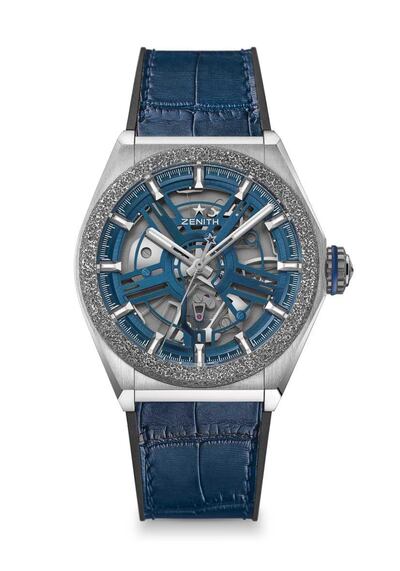
Before bowing out of daily responsibilities heading up LVMH’s luxury watch division, Jean-Claude Biver’s last act as the genius of watchmaking’s modern age was to consolidate the technical minds of Tag Heuer, Zenith and Hublot. Meaning 2017’s far-out Defy Lab concept from Zenith has indeed defied the naysayers, by seeing the light of day in marketable form within less than two years – demonstrating what happens when a normally closeted industry pools its R&D resources. The renamed Inventor does away entirely with the traditional, tick-tick-ticking assembly of balance wheel, hairspring and lever escapement, replacing its 30 parts with just one: a single wafer of silicon, stencilled into Mondrian abstractness. It twitches at 15Hz, bringing the whole, openworked dial display to life, measuring an error of just one second across 70 hours’ autonomy. Nothing else mechanical comes close to that.
Women's Chanel J12
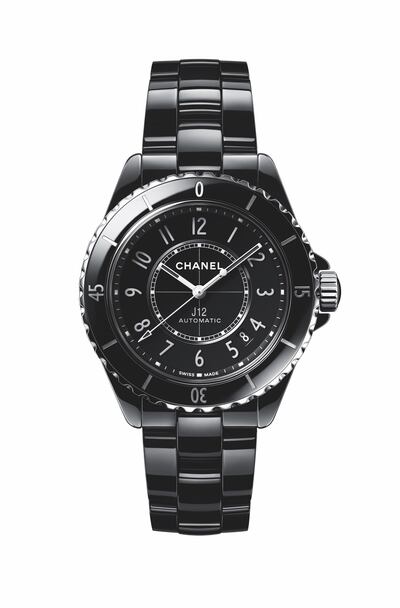
The J12 is back (not that it ever went away), but in a more refined guise. Arnaud Chastaingt, the director of Chanel’s watchmaking studio and the brains behind the likes of Monsieur, the Boy.Friend and the Code Coco, has said that he changed everything by changing nothing. In practise, his gnomic statement means the almost-20-year-old ceramic icon is sleeker and more refined, with some fascinating mechanics ticking inside. The team have sourced from the newly revealed Kenissi Manufacture – the industrial arm that Tudor established about five years ago to gain independence from mothership Rolex, 20 per cent of which Chanel acquired in January this year. Called the 12.1 calibre, the J12’s movement appears to be based on Tudor’s MT5621 chronometer, now boasting a slickly designed circular winding rotor emulating the bridges beneath. Chanel is clearly making a renewed, highly fashion-forward bid for a slice of the ticking women’s timepiece pie. Omega and Tag Heuer might want to watch out.
Gucci Grip
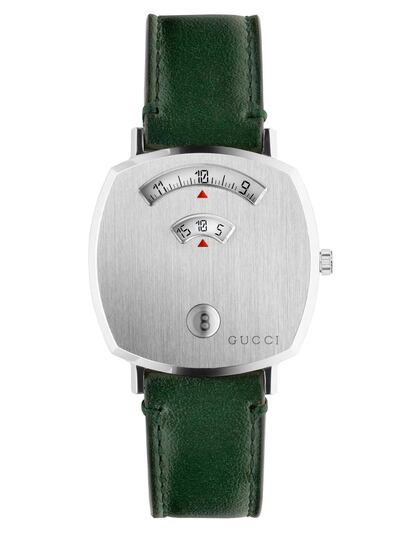
Until now, Gucci’s creative director Alessandro Michele has contented himself with revamping old watch styles, such as the G-Timeless and G-Frame, but this year he has branched out into entirely new territory with this 1970s skateboard-inspired design. And it’s the wonderful mix of contrasts that we’ve come to expect from this risk-taking designer. Firstly, it doesn’t really look like a watch at all, more like a parking metre, with its cushion-shaped case – a stylistic nod to the places on a skateboard where your feet are placed. Deceptively, it resembles a jump hour; however, the circle at the bottom reveals the date, while the two apertures at the top show the minutes and hours. While there are myriad case and strap options to choose from, there’s something perennially elegant about a steel case pared with a green strap. Time to get a Grip.
Breitling Superocean Automatic 36
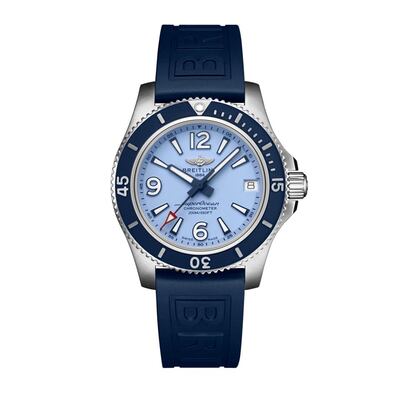
Breitling doesn’t really do cute; it does big, burly watches for men who do (or would like to do) daring things. Which is why this Superocean was such a surprise. Being Breitling, this is first and foremost a tool watch. It has a unidirectional bezel, rubber strap and is good to 200 metres, so you can take it scuba diving. However, it also wins in the style stakes, with a baby-blue dial that immediately conjures thoughts of sun loungers next to a sun-glossed blue sea. This is one of those rare finds – a practical timepiece that won’t earn you disapproving looks from the fashion police. Just pair with a Hunza G one-piece and some Saint Laurent shades for the ultimate summer look.
Rolex Oyster Perpetual Day-Date 36
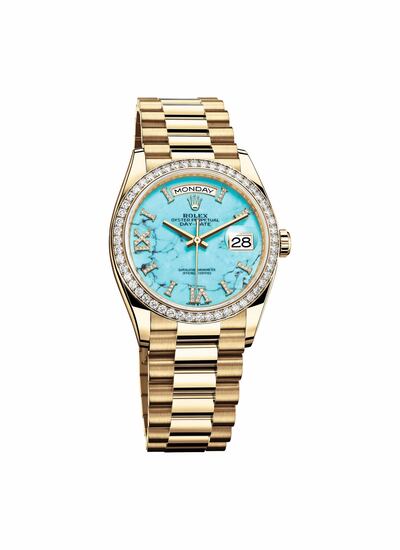
As day one of Baselworld dawns, all eyes are on the show’s biggest exhibitors, Patek Philippe and Rolex – both of which keep watertight embargoes prior to the event. So with the inevitable flurry of chatter regarding Rolex’s literally watertight Yacht-Masters, the women’s pieces were (typically) overlooked. But not here. An all-gold Day-Date has always had a 1980s shoulder-padded glamour about it, but now it’s been given an extra dose of pizzazz, courtesy of diamonds on numerals and bezel, and a very eye-catching turquoise dial. Due to the nature of the stone, every dial will have a distinctive set of markings, making each one unique. Powering it is Rolex’s new superefficient movement, with a three-day power reserve, so it will still show the right day and date on Monday if you take it off on Friday. Though when something looks as fabulous as this, why would you want to?
Reservoir Lady Longbridge
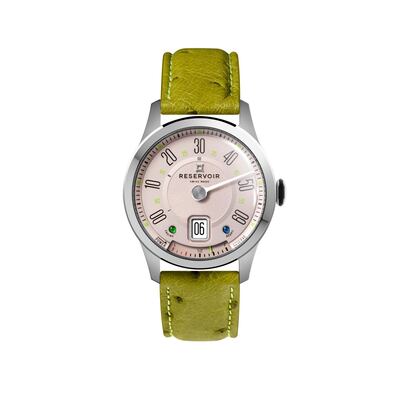
Driving watches tend to be geared more towards men – probably something to do with their links to automotive sport, which historically didn't have a place for women, unless they were scantily clad and draped on a bonnet. That's what makes this watch from France-based but Swiss-made Reservoir so refreshing and so cool. All of its watches have a jump hour at six o'clock and retrograde minutes, and take inspiration from either car or airplane dashes. As the name suggests, this dial is inspired by the dash of a vintage Mini (Longbridge being the name of the plant where the first Mini was built), complete with light indicators – only decorative, unfortunately. With its pale-pink dial and mint-green strap, it looks like the type of watch Thunderbirds's Lady Penelope would wear. Parker, ready the Rolls-Royce.
